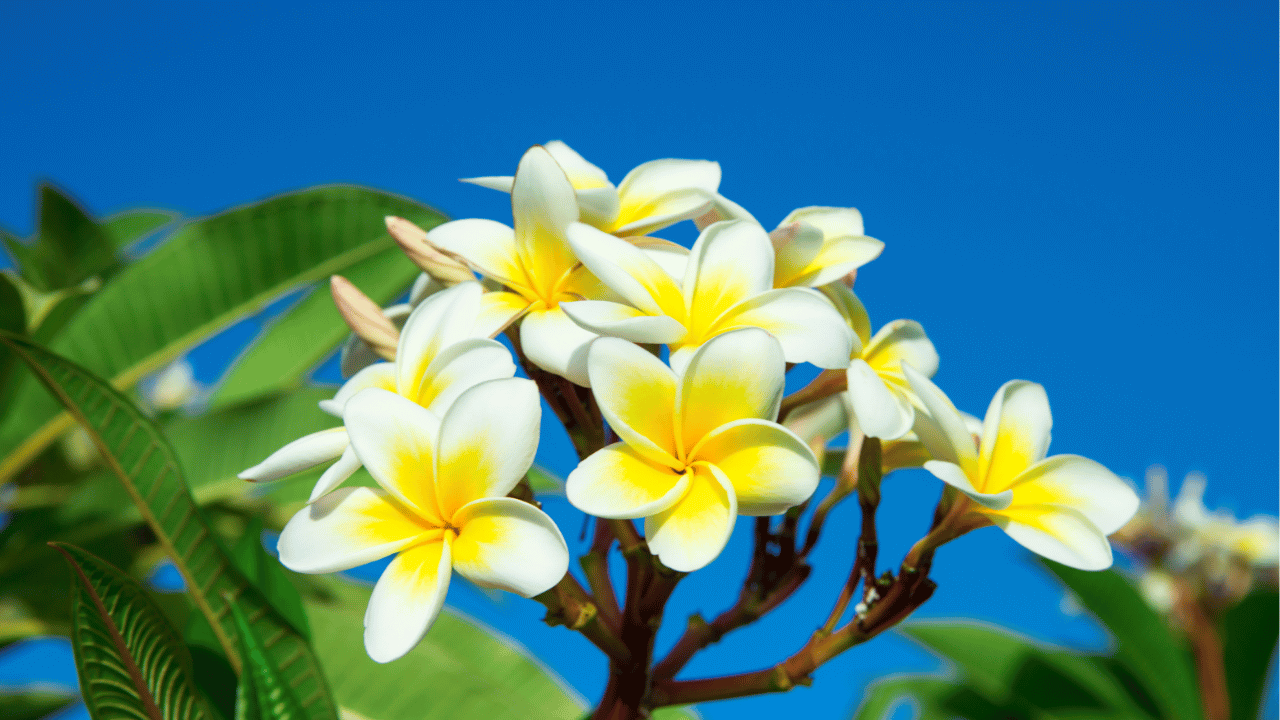Plumeria trees, known for their fragrant and vibrant blooms, are a favorite among gardeners. Although they are resilient and thrive in warm climates, proper care is essential to ensure healthy growth and prolific flowering. Here are 10 specific tips to help you maintain your plumeria trees, keeping them robust, vibrant, and flourishing throughout the growing season.
1. Provide Full Sunlight
Plumerias thrive best in full sunlight, needing at least 6-8 hours of direct sun daily. Without ample light, their blooming will reduce, and growth may become leggy. When planting outdoors, choose a sunny, south-facing spot to maximize exposure.
If growing plumeria in containers, ensure you position them in an area where they receive plenty of sunlight. In shaded conditions, consider moving the pots to sunnier locations as the seasons change to ensure consistent light levels.
2. Use Well-Draining Soil
Plumerias prefer well-draining soil to avoid root rot. A mix of cactus soil, perlite, and organic compost works perfectly to maintain moisture without waterlogging the roots. Be mindful of using heavy clay soils, as these will retain too much moisture and suffocate the plant.
If you’re growing them in containers, ensure that the pots have drainage holes. Adding gravel or small rocks at the bottom of the pot further enhances drainage, keeping roots healthy and dry.
3. Water Deeply but Infrequently
Plumerias enjoy a deep, thorough watering but only when the soil is completely dry. During the growing season, water them every 7-10 days, ensuring the soil dries out between watering. This encourages the roots to grow deeper and more resilient.
Overwatering is a common mistake with plumeria care. Excess moisture can lead to root rot and fungal issues. In cooler months or dormant periods, drastically reduce watering as the plant needs minimal moisture during these times.
4. Fertilize Regularly During Growth
During their growing season (spring to early fall), plumerias benefit from regular fertilization. Use a balanced, slow-release fertilizer with higher phosphorus content (10-30-10) to promote blooming. Feed them every 2-4 weeks for optimal results.
Avoid using high nitrogen fertilizers, as this will result in lush foliage at the expense of flowers. Instead, focus on phosphorus to encourage vibrant blooms and potassium for overall plant health and disease resistance.
5. Prune in Late Winter or Early Spring
Pruning helps shape your plumeria tree and promotes new growth, especially for older or overgrown plants. The best time to prune is in late winter or early spring, just before the growing season starts. Trim back dead or damaged branches, and remove any crossing stems to allow more light and air circulation.
Don’t be afraid to prune your plumeria heavily. It will recover quickly and reward you with more blooms. Just make sure to use clean, sharp tools to avoid introducing diseases.
6. Protect from Frost
Plumerias are tropical plants and are highly sensitive to cold temperatures. If frost is a possibility, protect your plumeria by bringing it indoors or covering it with frost blankets. For trees planted directly in the ground, consider adding mulch around the base to insulate the roots.
In areas where frost is frequent, growing plumerias in pots may be the best option. This allows you to easily move the plants indoors during cold snaps and avoid potential damage.
7. Repot Every 2-3 Years
For container-grown plumerias, repotting every 2-3 years is essential to avoid root-bound conditions. When repotting, choose a pot that is 2-3 inches larger than the previous one, and replace the soil with a fresh, well-draining mix.
Repotting not only gives the roots more space but also replenishes nutrients in the soil. Be sure to water the plant thoroughly after repotting and allow it to acclimate to its new environment for a few days before resuming regular care.
8. Use Proper Mulching Techniques
Mulching is beneficial for plumerias, especially when planted in the ground. It helps retain moisture, keeps the roots cool, and reduces weed competition. Use organic mulch like bark or compost, but be sure not to pile it against the trunk to avoid rot.
A thin layer of mulch also provides some insulation against temperature fluctuations. Replenish the mulch layer every year, particularly before the growing season, to maintain its effectiveness.
9. Watch for Pests and Diseases
Common pests like spider mites, whiteflies, and aphids can attack plumerias, especially during the warm season. Regularly check the undersides of leaves for signs of infestations. Use insecticidal soap or neem oil as a natural remedy for these pests.
Additionally, be on the lookout for fungal diseases like rust. Yellowing leaves with orange pustules are a telltale sign. Remove affected leaves immediately and ensure good air circulation to prevent the spread of disease.
10. Allow a Dormancy Period in Winter
Plumerias go dormant in winter, shedding leaves and requiring less care. During this time, stop fertilizing and reduce watering to once every 3-4 weeks. Dormancy is essential for the plant’s overall health, helping it conserve energy for the next growing season.
Don’t be alarmed if your plumeria looks bare during winter—it’s a natural process. Come spring, your plant will bounce back with new leaves and abundant flowers if given proper care during dormancy.

